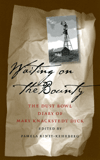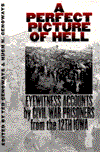Waiting on the Bounty
“Dyck’s diary is a treasure trove for historians; detailed personal accounts written by ordinary people, and especially by farm women, living in the dust bowl region during the 1930s are rare. . . . Moreover, Riney-Kehrberg’s introductory essay, ‘A Woman in Her World,’ provides a rich interpretive foundation for the diary, acquainting the reader with Mary Dyck’s background, her children, her community, her farm, and agricultural and economic conditions of the 1930s.”—Great Plains Quarterly
“As an historical document that details the life of an uneducated, middle-aged farm woman on the Great Plains, one that was 'defined by family, home, and farm,' and as a report on the Dust Bowl and its impact on farmers and families, Waiting on the Bounty is an essential work.”—Nebraska History
“A powerful document . . . that provides true insight not only into rural life in Kansas but also into the innermost thoughts and concerns of a farm woman. At the same time, the diary gives an incredibly realistic view of the physical hardships on the Great Plains during the dust storms.”—Dorothy Schwieder, author of Iowa: The Middle Land
“Written primary source materials from rural women with little education are rare, as are social histories of the Dust bowl. We are, therefore, indeed fortunate that Mary Knackstedt Dyck recorded her southwestern Kansas farm family's activities ... We are fortunate also that this diary comes to us as part of the larger research agenda of a mature scholar.”—Joyce Thierer, Western Historical Quarterly
“Pamela Riney-Kehrberg, in her beautifully edited presentation of Mary Dyck’s 1936–1941 diary, opens up a memorable window onto one of the most compelling—and difficult—decades of Kansas history. . . . Waiting on the Bounty is a valuable addition to the very limited number of available memoirs of 1930s Kansas farm life.”—Kansas History
“With each observation, the inner-world of an ordinary farmwoman unfolded in an interesting account of family, community, and rural life.”—Brad D. Lookingbill, Agricultural History Review
The daughter of German immigrants, Mary Knackstedt married Henry Dyck, a Mennonite farmer, and in 1905 moved west to a settlement near Lamont Township in Hamilton County, Kansas. For the next thirty years they enjoyed growth and prosperity. Then the drought and dust storms that had driven many farmers from the region in the early years of the century returned. The Dycks remained on their farm and witnessed the mass exodus of farmers and townspeople—including close friends and family—who fled the Kansas wheat country to find work.
Though she had only a fifth-grade education, Mary Knackstedt Dyck faithfully kept a diary. Written with pencil on lined notebook paper, her daily notations tell the story of farm life on the far western border of Kansas during the grim Dust Bowl years. Manuscript diaries from this era and region are extremely rare, and those written by farm women are even more so. From the point of view of a wife, mother, and partner in the farming enterprise, Dyck recorded the everyday events as well as the frustrations of living with drought and dust storms and the sadness of watching one's children leave the farm.
A remarkable historical document, the diary describes a period in this century before the telephone and indoor plumbing were commonplace in rural homes—a time when farm families in the Plains states were isolated from world events, and radio provided an enormously important link between farmsteads and the world at large. Waiting on the Bounty brings us unusual insights into the agricultural and rural history of the United States, detailing the tremendous changes affecting farming families and small towns during the Great Depression.
Pamela Riney-Kehrberg has provided an edited version of the diary entries from 1936 to 1941. Her informative introduction tells the story of the Dycks' settlement in western Kansas and places the diary in its historical context.
Preface
Chapter 1: A Woman and Her World
Chapter 2: Work, Family, and “Playing Hookie”: 1936
Chapter 3: Blowing Dust and Departures: 1937
Chapter 4: A Little Snow, a Little Rain, and Hope: 1938
Chapter 5: Dust and Hope Deferred: 1939
Chapter 6: Blizzards, Rain, and Bounty: 1940
Chapter 7: The End of an Era: 1941
Epilogue
Appendix
Notes
Bibliography
Index






